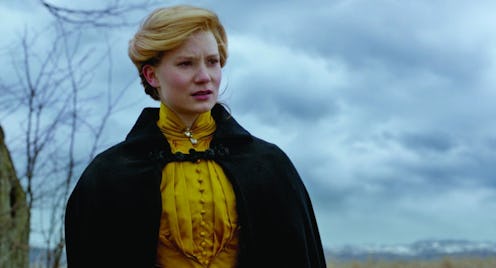Entertainment
How Gothic Horror Influenced 'Crimson Peak'

As Crimson Peak's Edith, Mia Wasikowska plays a writer, a Buffalo, New York native, who meets Tom Hiddleston's mysterious, eccentric British aristocrat Sir Thomas Sharpe, and his sister Lucille (Jessica Chastain). Edith is an aspiring novelist — fittingly, as her name, Edith Cushing, is a nod to both Edith Wharton, the author of House of Mirth and The Age of Innocence, and Peter Cushing, the British actor known primarily for his work on horror films with the Hammer studio. Crimson Peak director Guillermo Del Toro has also noted a number of literary references that contributed to the film's aesthetic, so is Mia Wasikowska's Crimson Peak character based on a real writer?
Edith draws comparisons to Jane Austen in Crimson Peak, which she perceives as a slight — she doesn't want to be a romance writer. She prefers horror. (She's in the right movie for that.) Her role model, instead, is Gothic horror writer Mary Shelley, the author best known for Frankenstein. But even when she writes ghost stories instead of romances, these are seen as quaint and endearing rather than terrifying. Unlike Shelley, who was treated as a serious novelist during her lifetime, Edith struggles to be taken seriously. (However, since Shelley's death, the author has been primarily remembered for Frankenstein alone among her written works, and beyond that, as the wife of Percy Bysshe Shelley.)
Literary forbears aside, Edith isn't based on any one real writer; she's an amalgamation of influences based on the role of women in the Gothic horror movement in the late 19th and early 20th centuries. But Crimson Peak as a whole is similarly steeped in Gothic influences, many of which Del Toro has cited in interviews and likely influenced how he portrays Edith beyond her writerly aspirations.
In an interview with The Daily Telegraph, Del Toro cited film adaptations of both Shirley Jackson's The Haunting of Hill House and Henry James's The Turn of the Screw among the haunted-house precedents for Crimson Peak. In Jackson's novel, which was adapted in 1963 into The Haunting, a ghost hunter named Dr. Montague rents out Hill House in order to investigate claims that the manor is haunted. He's accompanied by a few friends (the only few friends who would accept his invitation to live in a haunted house, as it happens), and one early line in particular seems particularly relevant in the comparison to Crimson Peak: "Hill House has a reputation for insistent hospitality; it seemingly dislikes letting its guests get away." Hill House sounds quite a lot like Allerdale Hall. And as the Wall Street Journal reported, Jackson's story itself was based on an eerie sleepwalking tale from a Vermont housewife.
Likewise, The Turn of the Screw plays out in the traditional manner of the haunted house tale. A narrator-governess is called upon to look after two British child-aristocrats, and she soon begins to see evidence that the house is haunted, and the children themselves might be responsible for summoning the ghosts. Edith's story in Crimson Peak has obvious precedents — the outsider, often a woman, arrives at a storied but mysterious mansion, perhaps a bit derelict, only to find that not everything is as it seems. Adding an additional layer of textual references — Edith's burgeoning career as a writer — only reinforces the literary influence that already infuses the film.
But it's also impossible to discuss Gothic influences without mentioning Horace Walpole's Castle of Otranto, the novella that arguably sparked the Gothic horror movement. It was published in 1764, and as a result it's one of the earliest novels that can be attributed to the Gothic movement. The familiar tropes are all there — a castle fallen into disrepair, maybe haunted, and in a distinct parallel with Crimson Peak, an aristocrat who marries a woman (fiancee of his late son, as it happens) in order to avoid a dark prophecy becoming reality.
So strong are Crimson Peak's literary influences that it's earned the approval of Stephen King, the contemporary master of the horror genre. As the BBC noted, even Jane Austen's baroque Northanger Abbey is a romanticized nod to the haunted mansion that is as much a character as any man or woman in many Gothic novels. Though she's not based on any specific, true-to-life author, Mia Wasikowska's Edith Cushing bears clear influences from some of the most well-respected horror novels of the past 200 years, from Walpole's Isabella to Jackson's Montague.
Images: Universal Pictures